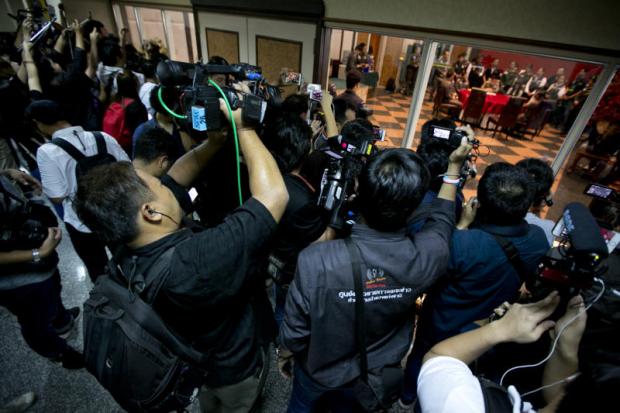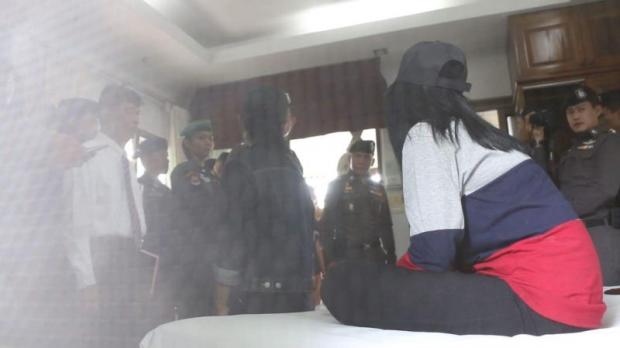For criminal suspect Preeyanuch "Preaw" Nonwangchai, being the star of a high-profile murder case has landed her more publicity than punishment. For the past two weeks, the 24-year-old's face has been seen on the front page of every newspaper and every TV channel in Thailand. People's attention has been held rapt by the young woman who allegedly killed and dismembered her victim in a viral criminal case.

overexposure: Instead of facing public shaming, Preeyanuch ‘Preaw’ Nonwangchai, one of the suspected murderers of 22-year-old Warisara ‘Am’ Klinjui, has become a celebrated viral sensation.
On social media, several Facebook pages and groups have published their personal takes on the case, drawing in large volumes of shares, likes and views.
Picking up on the online buzz, the mainstream media has in turn begun to fixate on what people are calling the "Preaw Phenomenon".
A poor farm girl who grew up in a broken family in Khon Kaen, Preaw saved up enough money to undergo drastic plastic surgery. After the procedure, she begun work as a bar girl.
Her involvement in an undercover drug circle allegedly led to conflict with her friend, Warisara "Am" Klinjui. Preaw is said to have strangled Am to death on May 23 and tried to conceal the victim's identity by cutting her body in half. She then placed the body in a barrel and buried it at an underground site in the Khao Suan Kwang district of Khon Kaen.
Over two weeks, Preaw shot to star status in Thailand. But some are concerned about the positive reception that she's received from the media.
Academics, psychologists and media monitoring experts are grasping to explain why Preaw has been embraced like a beloved celebrity, and how this tells of the state of Thai society.
CELEBRITY CRIMINAL
"The name on everybody's lips is gonna be Roxie", goes the song lyrics from the hit musical Chicago. Anyone who's seen the show or film knows that the lyrics refer to the lead character Roxie Hart, who gets famous for killing her husband. The fame circus that follows Roxie shares parallels with the Preaw phenomenon.
Chicago, set in the 1920s, depicts the lives of female murderers who've gotten away with killing their husbands thanks to whip-smart lawyers and public sympathy. The two main characters, Roxie Hart and Velma Kelly, become influential figures and household names, setting new hairstyle trends and inspiring a merchandise machine.
"When we think of the story of Chicago, written in the 1920s about two female murderers, we can see that Thailand is reacting in a similar way in the case of Preaw," says Pawit Mahasarinand, the chairperson for Chulalongkorn University's Department of Dramatic Arts, explained. "Everybody says her name, and whatever she wears or uses becomes a hot fashion item. There's even people making merchandise based off her.
"It's quite shocking to see that this story, inspired by true events that took place almost 100 years ago in America, is now happening right here in Thailand. It's started to get people thinking about the justice system and the corruption in our country that is still very backward," he added.
Asst Prof Munyard Akkarachantachot, an academic from the Faculty of Communication Arts at Chulalongkorn University, used Google Trends, a data base for search engine patterns, to compare news coverage between two public figures, famed for separate reasons -- Preaw and Pro May.
The latter is a professional Thai golfer who was recently mistakenly named as the world's number one female golfer in a faulty index calculation.
The results Ms Munyard found were surprising -- the graph generated from June 3 showed that news about Preaw's arrest took up 80% of coverage, while Pro May, a big celebrity name, took only five percent of the figure on the same day.
"The Pro May news is pretty straightforward," Ms Munyard explained. "But Preaw's story has so many different elements to examine and investigate.
"When the police held a press conference about Preaw's arrest, more media people showed up than when the police held a conference about the 2015 explosion at Ratchaprasong. It shows that people nowadays care more about soft news than real security matters."
ALL EYES ON PREAW
Making a news story about a dog biting a human won't capture much attention. But a story about a human biting a dog -- that is a case that would pique public curiosity. People are perplexed when they come across an unlikely perpetrator.
Ms Munyard says that the Preaw phenomenon has much to do with how her attractive looks contrast with the ugly murder accusations directed at her.
Her life story is also complex and dramatic, something Thais are drawn to.
"Although Preaw's case is nothing more than soft news, the level of attention that the media has given it has make it seem more important than it is," she says. "Humans by nature like any story that features sex and aggression as major elements. Preaw's story happens to have both of them. That's why her story sells so well."
In elevating Preaw's story to the height of spectacle, the media has fed a morbid public curiosity. When people are curious about a topic or person, they tend to seek out information to satisfy that interest. The media supplies that demand.
"Perhaps Preaw's story holds more of an appeal over more important stories because people love the narrative of the character, the conflict and the emotion behind it," Ms Munyard explains. "We are more drawn to the drama of the piece than what its actual implications for us the people are."
That the story was initially mass circulated by social media channels shows that the public played a powerful role in pushing it to the forefront of the news cycle. Everybody can be a reporter nowadays and determine what stories matter most.
"But social media users are not professional journalists," Ms Munyard says. "They only care about how many people views their pages get and how quickly they can publish stories that they find on the internet…Sadly, they treat people from news stories like characters more than real human beings."
ACT TO FOLLOW
Assoc Prof Sompoch Iamsupasit, a psychology academic at Chulalongkorn University's College of Public Health Sciences, says that the Preaw phenomenon is cause to worry for Thai society. Young people watching Preaw's story unfold could idolise her for her lavish lifestyle, instead of disparaging her for her crime.
"The mainstream media must stop following social media trends," Mr Sompoch says. "They need to draw a distinction between how we treat criminals and how we treat net idols. Criminals are not idols -- they do not set a good example.
"I understand that the media sells news for a living and this news happens to draw a lot of attention. But whenever the media stops overexposing an issue, the unhealthy fixation on it will stop. The media should emphasise that bad people will be punished, not rewarded with popularity and support like Preaw," he added.
Mr Sompoch told Spectrum that in research he has conducted concerning the mental health of Thai people, he found that 2.5% of Thais have what can be classified as extreme personalities -- as Preaw is speculated to have.
"It is sad that parents nowadays are only concerned about preaching materialism," said Mr Sompoch. "They teach their children to be smart so that they can get into a good school and get a good job that will make them rich. But not many parents teach their kids how to be a good person."
Uajit Virojtrairat, director of the Foundation for Media Studies and a sub-commission member of Broadcasting Media Consumer Protection, is concerned that Preaw's case will encourage copycat criminals.
"There are many people like Preaw out there," Ms Uajit explained. "People who are idolised based on their physical appearance alone can be looked up to as heroes.
"This phenomenon has been created by both social media and mainstream media, and it is a good opportunity for us to see the differences in terms of the quality between professional media and amateur media. But for Preaw's story, there is no difference between the twos' coverage.
"The media now fixates on beauty and wealth more than teaching people a lesson. Continuing to publish images of Preaw's lifestyle like the ones of her laying on a bed of money or screenshots of her using bad language on Facebook can only produce negative effects. Repeatedly showing her bad behaviour tells people that she deserves the spotlight and attention.
"Trust me, there are a lot of people like Preaw out there and they see her as an idol now."
THE FAME FACTOR
According to Ms Uajit, using a media monitoring framework helps explain how Preaw's case spiraled into the viral story it is today. SLVR theory -- an acronym for sex, language, violence and representation -- breaks down what elements draw in viewership numbers, but also might require censorship measures.
The first letter in the acronym refers to "sex". Any story that features sex draws attention easily, and Preaw's case is no exception to the rule. The media has capitalised on a slew of sexy images she's posted online of herself, helping keep people's eyes on her.
"Of course, social media started the stir [around Preaw] but the mainstream media gave it more of a momentum by republishing these images and videos," Ms Uajit explained. "I think it is unacceptable that one TV channel showed the video of Preaw having phone sex with her boyfriend, allowing her moaning sounds to be aired on TV. Mainstream media should be more ethical than that."
The language the media uses to describe Preaw is also indicative of why she's been embraced by the public. News sources like to play on the contrast between her innocent-looking beauty and alleged dirty crime. At the same time, they emphasise that it is the former that fortunately brings her fame and wealth.
Another element contributing to the appeal of Preaw's story is the violence behind it. However, people should be wary of violent copycats, says Ms Uajit.
"Instead of showing more stories about the victim in this case, the media only chose to pick up on the story of Preaw, which is full of violence."
The last word of the acronym is about how her story is represented. Preaw is a complex character -- she's beautiful but dangerous; she's immoral but she also works hard to give money to her mother. Her contradictory image draws people towards her case.
"Since she's now being accepted by people as a hero instead of the lead suspect in a murder case, many people will try to be like her," said Ms Uajit. "For me, that is the most dangerous part. It's almost like the statement that goes 'If you can't be famous, be infamous.' The media is now helping her create that image."
NORMAL ACTIVITY
Asst Prof Puchong Laurujisawat, a lecturer and PhD from Chulalongkorn University's Department of Psychiatry, can understand why many believe Preaw suffers from mental illness, given the murder accusations against her.
However, Dr Puchong says he sees limits to those accusations.
"Whenever people show abnormal social behaviour, society will start blaming that person, accusing them of being a psychopath and of suffering from mental illness. But when people use the term psychopath, they tend to refer more to people's negative attitudes than actual medical facts," Dr Puchong explained.
"Please stop referring to and stereotyping all murderers as being psychopaths," Dr Puchong said.
"This very often isn't the case. In fact, there are many murderers who are not mentally ill. Their mental health can seem absolutely normal just like the rest of us."
He further explained that if the murderer does indeed have mental issues, the doctor would never publicise this information unless a court order is issued to do so. Assessments of people's mental state are generally a secret held between doctor and patient.
He cautioned people to be careful to not pathologise suspects by their minute behaviour -- for example, Preaw's seemingly unapologetic facial expressions.
"Preaw's case tells the story of what audiences want to hear. So don't be biased. Don't jump to the conclusion that all murderers are psychopaths and don't violate other people's rights and privacy," Dr Puchong cautioned.
EXERCISING AWARENESS
Academics from media studies to psychology want the public to be more critical about how they approach stories like Preaw's. If the media is selling more drama than real news, this is a problem that demands a solution.
Mr Sompoch says these stories should be dropped before they create damage.
"The more the media normalises violence, the more we will get used to it, and that's very dangerous since we will not see it as something wrong any more," he says.
"We will get used to the violence and maybe even use it to solve problems. It will also make people act more violently since they think of it as normal.
"I really am concerned about children. They start to remember news and information from the age of about seven years old. What will happen in the next 10 years if they start thinking it is acceptable to use violence to solve problems from these stories?" he added.
Family ties are being loosened as parents work full-time office jobs, and have less time to raise children by themselves. When there's a lack of time to entertain kids, they tend to be plopped in front of a screen -- a TV, tablet or computer screen. Sometimes, parents cannot control the content their children encounter.
"My concern is that younger generations tend to be more attention seeking. Since they don't get as much attention from their parents, they seek acceptance from their peers through social media," Mr Sompoch suggests.
Ms Munyard says that media quality must be more effectively controlled.
"It's best for the mainstream media not to compete with social media, she says. "They should understand that this is what makes them different from professional journalists who work within strict ethical guidelines. Let this phenomenon be an example of how we should strive for better quality for media in our country."
Meanwhile, Dr Puchong compares the news to food -- there's good food and bad food out there, and the smart consumer only chooses what's most healthy for them. However, there is bad food out there that is tempting enough to sample from time to time. It's up to the consumer what they eat in what proportions.
"The best way to prevent us from overexposure to negative media content is to learn how to read media. To do so, this means that we have to try bad things before knowing it is bad so that we do not do it again," Dr Puchong explained.
"We should let our children and even ourselves be exposed to poor quality content and news in order to be able to eventually discern what is good and bad. That way, we'll know in the future what to believe and what we shouldn't.
"I don't believe the media is more powerful than parents' words. If any family lets the media control their children's thinking and behaviour, that means they are lousy parents," he added.
"Maybe what we should teach our society more is to have empathy. We should be more empathetic to everyone, even wrongdoers. When we have that, we can limit the possibility of any future violence," Dr Puchong said.

public spectacle: National Police Chief Chakthip Chaijinda hosts a press conference for the arrests of Preaw, and other suspects Kawinta 'Earn' Ratchada and Apiwan 'Jae' Satayabundit on June 4. PHOTO: Kris Promsaka Na Sakolnakorn

worse for wear: The shirt of murder victim Warisara 'Am' Klinjui found in a vehicle. PHOTO: JAKKRAPAN NANTHARI

the hot seat: Preaw attends the crime reenactment of the murder of Warisara 'Am' Klinjui. Preaw is said to have ran into conflict with Am after the suspect got caught up in undercover drug circles. PHOTO: JAKKRAPAN NANTHARI

locked up: The head of the central prison in Khon Kaen, where the three murder suspects were held in custody. The women were ordered to be jailed separately from each other. PHOTO: JAKKRAPAN NANTHARI

facing up: National Police Chief Chakthip Chaijinda questions Preaw at the Royal Thai Police HQ after she was flown to Bangkok from Chiang Rai. She confessed to the murder accusations against her. PHOTO: Pattarapong Chatpattarasill
